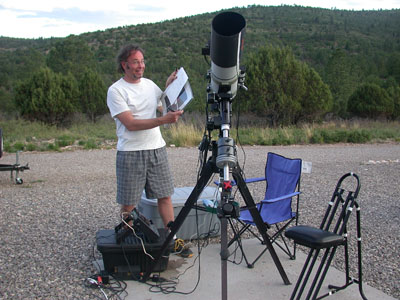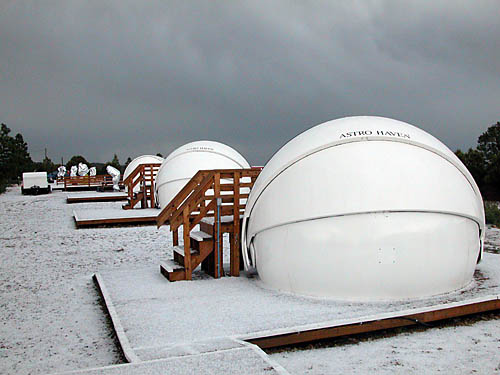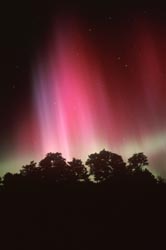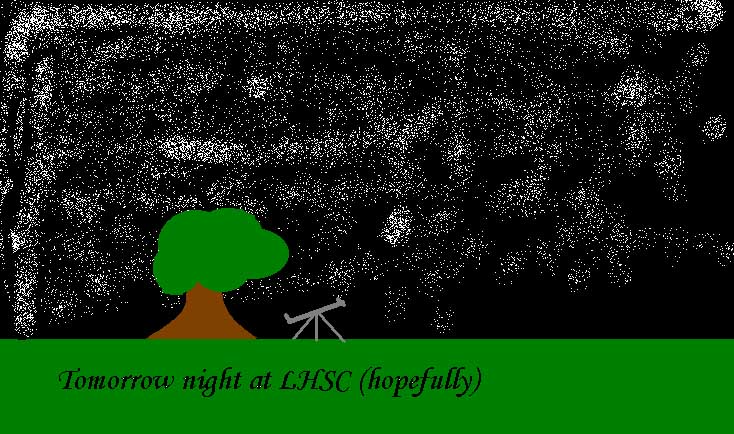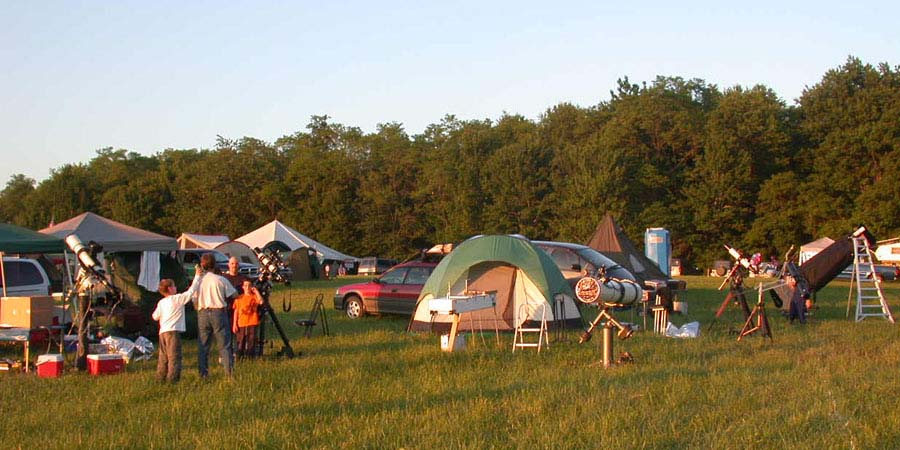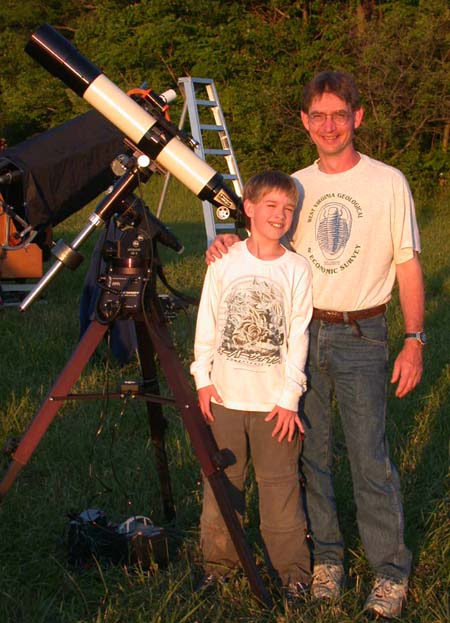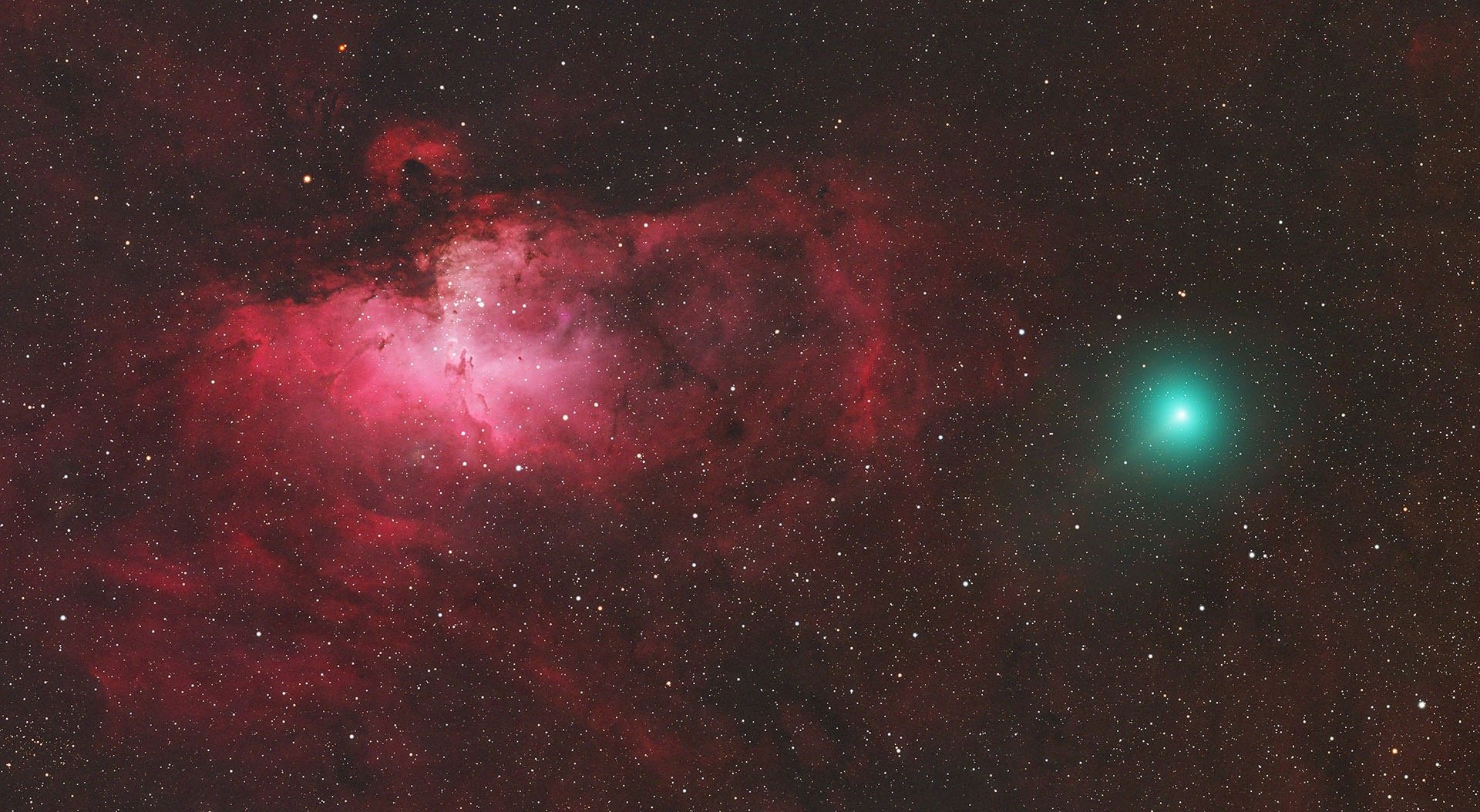NEAF 2002

This is NEAF on Saturday morning. The Televue line is on the left. Cash only, please<g>
NEAF 2002: An Astrophotographer's Perspective
May 18-19, 2002
How convenient, my company decided to hold a meeting in Newark, NJ the week prior to NEAF. This provided a great opportunity for me to attend the highly acclaimed event for the first time.
Rockland Community College, site of NEAF, is located 40 miles north of the Newark airport. The gymnasium facility is very appropriate for the event with ample space for vendors and an appropriately sized auditorium for the presentations.
Over 60 vendors ranging in focus from miniature telescopes to Software Bisque and the Paramount mount were on display for the two days. The full program and list of vendors can be found at http://www.rocklandastronomy.com/neaf.htm
I realized on Saturday morning that I had made the transition to a pure astrophotographer when I had no desire to stand in the Televue line for deals on eyepieces and other viewing equipment. Al Nagler is always a great participant in this event. He enthusiastically shared his telescope and astronomy knowledge with many attendees.
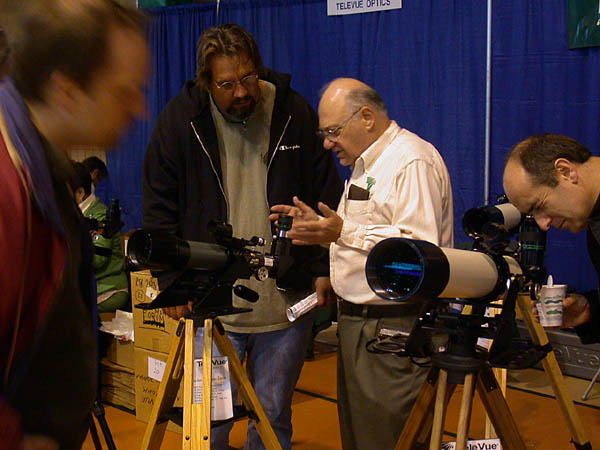
Mr. Al Nagler shares his telescope knowledge with attendee
Event highlights:
Dr. Rob Gendler lectured and presented his astronomical images. I must say, I have long admired the web presentations of Dr. Gendler's images, but seeing those huge prints up close was even more impressive. The images were smooth and had great dynamic range. The presentation was very comprehensive regarding all aspects of CCD astronomy. His lecture was one of the most well received during the entire conference. My short time to interact with Rob was very enjoyable and educational. It was obvious that Rob has a tremendous passion for imaging and his commitment to excellence is second to none.
For Rob Gendler's online images, please go to
http://www.robgendlerastropics.com/
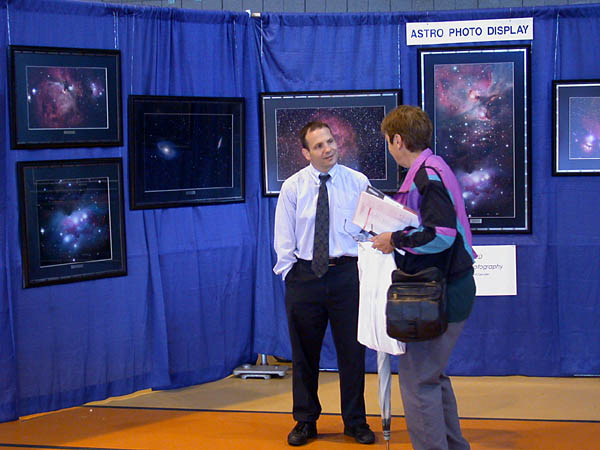
Dr. Gendler shares views of his images with attendee
Vixen telescopes. Vixen was on display with Highpoint Scientific. According to Bill Copeland, Vixen sales manager, the company is now a division of Tele Vue Optics. The Vixen telescope catalogue got me very excited. Great offerings for the astro-photographer like their medium format capable DED 108SS doublet ED refractor with 540mm focal length at f5. Many other great telescopes and astrophotography accessories. The Televue/Vixen relationship will prove to be very interesting to watch as time goes by.
Software: There were two very interesting software offerings presented.
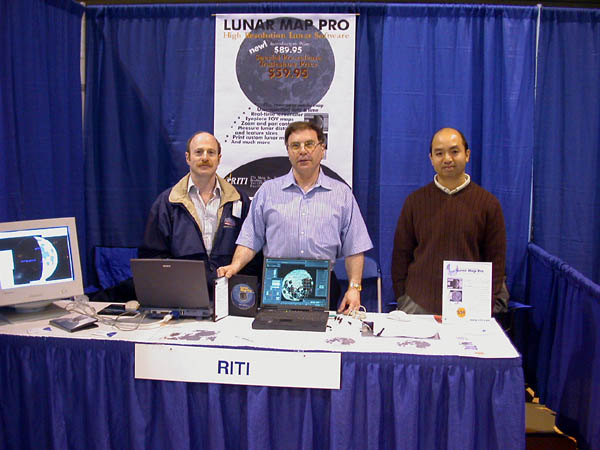
Lunar Map Pro: Mr. Hung Q. Pham (right) and colleagues are preparing to launch a very interesting high resolution Lunar software, Lunar Map Pro. More information can be found at www.riti.com
For lunar observers, this may become the equivalent of planetarium programs like The Sky or Megastar. Observers will be able to print custom lunar maps, flip, reverse, or rotate the map to match the view through any telescope, measure lunar distances, and more.
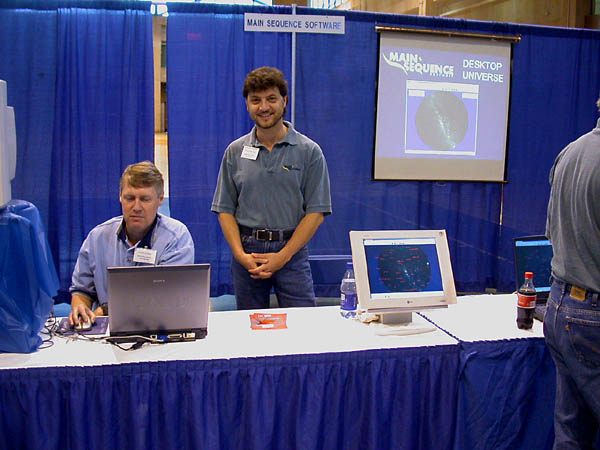
Main Sequence Software: Desktop Universe You may have seen the teaser ads in Sky and Tel for Desktop Universe. Mr. Peter Ceravolo (standing) and his colleagues demonstrated the software at NEAF. Imagine a planetarium program overlaying a mosaic image of the entire sky! Yep, that's right. The ENTIRE sky. Imaging was done at two locations: Sun Glow ranch in Arizona and a site near Ayer's Rock in Australia. The imaging itself was performed with a CCD AP9 with 3k by 2k array size and total of 20,000 images all one minute in duration! Peter designed the 150mm lens and also used a custom GOTO mount. The effort is quite impressive. I can't wait to see the full release software. Expected release date is July 1. For more info go to http://www.desktopuniverse.com/

David Levy: Tails and Trails: A lifetime of observing the night sky. Can you remember what event first sparked an interest within you for astronomy? Mr. Levy recalled the days of his youth in a summer camp where his first glimpse of a meteor sparked his interest in astronomy. That passion has not waned to this day. It was ironic in a way to listen to Mr. Levy. It was his comet, Shoemaker/Levy 9, that rekindled my interest in astronomy, now over 8 years ago. David's passion for the simple beauty of the night sky is contagious. I find myself cluttering my original wonder of the night sky with concerns over mechanical or equipment functionality. Mr. Levy has helped me to regain the original wonder I discovered on my first nights out with the stars...I will never let that wonder become a faded memory again.
There were many other great products and presentations. The solar presentation by Dr. Mary Lou West was outstanding, as well as Dr. John Grunsfeld's (NASA astronaut) presentation on the Hubble Telescope upgrade. NEAF is a world class event. If you have an opportunity to check it out, I heartily recommend you do. Clear skies, Jeff.
Sunglow Ranch Astro-Photography side trip May 2003
Sunglow Ranch near Pearce, AZ-May 26-27, 2003
Nestled in the foothills of the Chiricahua mountains, Sunglow Ranch is a great retreat for astrophotographers.
The cloudy weather pattern at New Mexico skies looked relentless. The satellite images showed a swirl of cloud formation reaching northwestward from Mexico and Texas into the Sacramento mountains. The cloud pattern never seemed to reach into Arizona. There was a wall of clear skies to the west that seemed to be an opportunity for eager astro-imagers On the 3rd day of monitoring this activity, Ernie and I decided to make the move: we were relocating to Sunglow Ranch in southeast Arizona. We made a quick phone call to Sunglow to confirm that rooms were available. After a couple of hours packing gear, we were off on the 6 hour trek across the desert southwest. This was my first driving experience in this region. All of my westward trips have been via airlines. Yes, you can see forever. Mountains on the horizon seemed to take forever to reach at interstate speeds. Pecan tree farms, wineries and dust devils would occasionally break the monotony of the brown and rocky landscape. Ernie and I were skeptical that we would reach the break in the clouds as we continued westward. Upon reaching Wilcox, AZ, we knew we had made the right decision to relocate. The clouds were well to the east and the skies overhead were dry and clear.
Arriving at Sunglow, there was a quiet relaxing atmosphere that soothed any anxieties we had about the place. Three concrete pads welcome the astronomer. The pads are nicely sized to accommodate at least one photographic setup if not two. The pads are about 100 yards from the guest rooms. The landscape lights around the campus are extinguished at the end of twilight. The skies are very nice. A subtle light dome is present to the south-southwest and rises just above the mountain ridge. This may impact some exposures of far southern objects once they have passed the meridian. The Chiricahua mountains provide a beautiful backdrop for star trail photography. Other activities include hiking and birding. Sunglow is really a retreat from it all. Don't expect to communicate with the outside world without a fair amount of effort. This truly was a relaxing and enjoyable environment for astrophotography.
This was the first night of imaging on the trip and was actually the first night I had imaged with this setup. I mounted my AP Traveler on a side-by-side plate with a Pentax 300mm lens and the STV Efinder riding on the low end of the 130 rings and plates. Unfortunately, this setup proved to be a little too much for the 600 mount. The work with the Traveler was not up to specs. The 300mm lens work was fine. I did shoot with Provia 400 on the 300mm and really did not like the results. This was unusual as I had previously like the Provia results. At least on this trip, I preferred the E200 color balance and overall presentation vs. the 400 Provia and thus made the switch to all E200.
Ernie Mastoianni was my buddy. Ernie has extensive photographic experience as a journalist for the Milwaukee Journal Sentinel. Ernie's setup included a G11 on a home built base with a Nikon 800mm f5.6 lens and ETX guide scope with assorted Hasselblad cameras and lenses riding piggyback.
This brings us to the topic of ambiance. Yes, I can't believe we are talking ambiance on an astrophotography trip, but it was certainly there at Sunglow. Breakfast and dinner are included in the overnight package price. I am not talking breakfast buffet at Hampton Inn. The breakfast and dinner was exquisite dining complete with fine wine at dinner. For me, this is the way an astrophotography trip should be; no worries in the world with the exception of taking good astrophotographs. The Sunglow staff numbers only a handful, but the hospitality is abundant. In just a few hours, everyone on campus will be greeting you by name. We just couldn't help but laugh when we thought of the ambiance we left behind at NMS with nine guys in a house. You know the ambiance that nine guys can create, right? Here we are with fine dining and great company. George and Saul also hooked up with us from NMS. They were enjoying visual astronomy and had been at Andy Homemeyer's place in New Mexico for a visit when they decided to meet up with Ernie and me at Sunglow. We also had the pleasure of meeting Jennifer from California. She was on a personal retreat and took in the hiking opportunities in the Chiricahua area. The fellowship among these friends was delightful. A truly enjoyable experience. One I will not forget.
From left to right: Saul, George, Jennifer, Ernie, and Jeff
Sunglow Ranch is a truly enjoyable astronomical location. I am scheming on how to return to this astronomical retreat as soon as possible, and I may even bring my wife for our second honeymoon!
New Mexico Skies Astro-Photography trip 2003
New Mexico Skies May 23-June 6, 2003
Immediately after our Chiefland trip in February 2002, the guys started talking about a desert southwest trip. We began to investigate sites and chose New Mexico Skies (NMS) as our destination. New Mexico Skies is the leader in remote and destination astroimaging for the amateur. Please see their website for the impressive list of imaging equipment on hand for users to rent on a nightly basis. In addition to the fine astronomical equipment, NMS has a complete library with internet access via desktops or wireless connection via your personal laptop. The library is also host to the midnight cappuccino treats-mmmmm.
The group started with Kirk Rogers, George Whitney, Warren Keller, and me, but that would soon change. I believe we had at least 9 guys in the clubhouse at NMS each night of the 2 weeks of our stay. It was a great group and "momma Whitney" made sure all of the fraternity boys were well fed and well behaved. Thanks "momma Whitney." Can you believe this? After changing travel plans many times, the final plan called for George and Warren to drive out a truck towing our equipment in a trailer. Wow, this permitted the rest of the group to fly to El Paso. We are eternally indebted to George and Warren for the trek cross-country. In some ways, I feel like I missed a unique opportunity in that truck. Many images on this page are courtesy of Ernie Mastroanni, Kirk Rogers, or Joe Schaefer. Thanks guys.
We had a little turnover of imagers/observers from week one to week two. States that were represented were West Virginia, Maine, New Jersey, New York, Wisconsin, Missouri, and Massachusetts.
Week one group from left to right.
Back row standing: Jeff Ball, George Whitney, Kirk Rogers, George Walker, and Saul.
Front row kneeling: Ernie Mastroanni, Joe Schaefer, and Warren Keller
Image courtesy Ernie Mastroanni
Matt BenDaniel explored the imaging potential of the tremendous on-site equipment at NMS. Matt is in the FCT150 dome with Mike Rice, owner of NMS. Matt captured some wonderful star trail shots at night and hummingbird shots in the daytime. Check them out here.
The imaging area at NMS is loose gravel with 2 concrete pads. Mike Rice shared with us that our group was the largest single group of imagers in the history of NMS. Two or three more concrete pads would be a nice addition to the area. We made do with patio blocks nestled down into the gravel and that proved to be stable for imaging. There are two power poles at the back of the area which provided plenty of power for our setups. Horizons are adequate for imaging at any elevation one would desire. You may be mindful of a tree on the backside that could possibly interfere with sighting polaris through a polarscope during your initial polar alignment for the evening.
George Whitney with a wonderful setup for photography with an AP 155EDF, AP Traveler, and two Bronica cameras all on an Astro-Physics 1200 mount. George shoots with medium format Pentax through the scopes and an ST10XME.
Kirk Rogers shows off his AP1200 with AP 130EDT, Takahashi FSQ 106, and Pentax medium format camera bodies with lenses for wide field imaging.
Warren Keller does wonderful work with his GM8, Intes MK69 f6, and Nikon camera lenses. You can see some of Warren's work featured at the Intes MK69 site here.
Joe Schaefer images with a Takahashi FS128, a Nikon camera and lenses with an Orion guidescope on an Astro-Physics 900 GOTO mount.
Image courtesy of Ernie Mastroanni
"Little Robbie Burgess." Yep, not too many people have a theme song, but you could hear Robbie's song echoing in the Sacramento mountains at night. Unfortunately, the weather never really allowed Rob to use the big dobsonian seen here. Rob was great company for a bunch of stressed out astroimagers.
Image courtesy Kirk Rogers
Dave Shimek ready to observe with his dobsonian. Dave drove in with Kurt Amuedo from St. Louis, MO. Check out Dave's images from the trip here.
Image courtesy of Joe Schaefer
My original plan was to shoot with this setup with the Traveler and Pentax 300mm lens on a side-by-side plate. I felt this was just a little too much for the 600 mount and switched to just the Traveler alone. Now I have a 900 mount and can image with the side-by-side configuration with no trouble. Skies looked promising this day, but as you know, clear skies in the day only get worse as night falls.
Image courtesy Kirk Rogers
Once again, the Astroglide team had a great time. It is wonderful fellowship doing what we love best. Rumblings of next year's trip have begun. Chile? Sunglow Ranch? Spruceknob, WV? Stay tuned.
The Storm-AAhh, Spring in New Mexico
The weather numbers were 5 out of 16 nights were photographic in that one could image all night with one night extremely dewy. The first few days were mired in a stagnant pattern of cloud formation coming from the southeast. The pattern brought to us a delightful spring hail storm, the likes of which I have never seen. A few of us were in the truck on the way to Alamogordo for shopping when it hit. A conversation was hard to hold inside the car with the pelting hail cracking on the metal. We were literally riding on a coat of hail 1" thick on the road. Ernie and I began to consider driving westward into Arizona. The weather pattern was stagant over New Mexico. So on day 3, Ernie and I pulled out for Sunglow Ranch, AZ. The images below capture the resulting ice cover after the hail storm. A truly unique experience. Not to be outdone, Kirk and George were nearly fried by a lightening strike. Warning: exercise great caution at high altitudes when severe weather is in the area. After this pattern broke, we experienced four straight nights of excellent skies. A new pattern settled in that saw convection run amuck. Low level moisture was rising at night and cooling forming clouds throughout the majority of the night. Unfortunately, we lost the entire second week of imaging to clouds.
Black Forest Star Party 2002
Dave Barrett of High Point Scientific with his Tectron 24" scope. Dave always provides some of the most incredible views at a starparty. I will never forget the H2 regions in M33, the spiral arms of NGC 6946, and the Horsehead nebula. Dave has his scope performing at maximum potential. Amazing real-time images. Thanks Dave!
Black Forest Star Party 2002 (extended)
Sept. 4-9, 2002
Another great Blackforest Starparty. Attendance continues to increase with a reported 450+ for 2002. Skies were great to fair on the 4 nights I was there. If you could have extended your stay, skies were great until Wednesday morning. The trees lining the state highway are a very nice addition. I encourage all who partake of the Cherry Springs park to consider supporting the Cherry Springs fund. More information at Gary Honis's webpage.
For more details on the event and site see the official website at http://www.bfsp.org/starparty/
The Aurora
The week had already been quite nice, but Saturday was shaping up to be " the night." I was moving to a more northern photographic target, when just as twilight started to wane I noticed a brightening in the north. I knew this was not a man-made light source. I said to my photographic friends, "Bummer, we have an aurora tonight." At first it was an undifferentiated green glow on the northern horizon, but by around 9:00 p.m., the show began. Most of the intensity was in the northwest in Ursa Major. Reds, blues, greens, bright white pillars, by far the best show I have ever seen. Ooohs and aahhs reminiscent of Independence Day fireworks rose up from the observing field. This was an ideal aurora, intensely bright and then diminishing before the photographic window was open<g> The aurora persisted in the north until around 2:00 a.m. with occasional brightening. At the peak, the aurora easily extended into Lyra near the zenith. What an amazing show!
Mike Peoples of Highpoint Scientific selling an astro-accessory
BFSP provides a great opportunity to learn from some of the best in the hobby. Whether it is film photography, CCD, digital camera, deep sky observing, or naked eye observing - you can find a knowledgeable person on your subject of interest. For me, it is great to see friends found through astronomy and often times through the Blackforest. I hope to return to Cherry Springs in the late spring of 2003. See you then!
Laurel Highlands Star Cruise 2002
Artwork by Chris Oyster on Thursday night during the heavy rain. His hopes were realized over the next two nights!
Turn to the Dark Side, my young apprentice
(a.k.a.) The Laurel Highlands Star Cruise
June 6-9, 2002
Opinion paragraph first<g>
I have never seen a harder working starparty crew than the one at Laurel Highlands Star Party. Terry Trees, Larry McHenry, Ed Moss, John Holtz, and many others have developed this event into a premier week-long starparty. They are not content with the current status. They are continually seeking out ideas and suggestions for improving the event. This year, there were many competing starparty events. I have not attended the New Jersey event, but I have attended the Mason Dixon event. If you want dark skies and a starparty, it seems to me that Laurel Highlands is your best bet for the spring in the east. Formal presentations began on Wednesday and concluded on Saturday. Observing began as early as Monday. Many of these activities are children events. I don't believe any event in the east offers programming to that extent. Perhaps the Winter Star Party. Is it a perfect sky? No. There is a light dome to the northwest from Uniontown. It is summer, who cares about the northwest? The summer Milky Way was breathtaking. You can read my observation report below for more details. Granted, Spruce Knob has a better total sky, but if you are wanting to combine a great weekend of observing/photography at a DARK site with a group of amateurs who share your passion for astronomy, Laurel Highlands Star Cruise serves as the standard to beat in the east coast for the spring/summer season. Black Forest is the place to be in the east for the fall schedule of starparties.
Camp:
The OVAS campsite on Saturday night
Observing/Astrophotography equipment in the camp: 20" Obsession, TV102, 10" Cave Astrola, AP 130EDT, TV101, 4" reflector, TV85, Fuji 7x50.
WE WON, again: Our winnings weren't as big as last year, but our camp did well with respect to door prizes. Chris O won the Orion case, Dave T won the planisphere, and I won the set of Night Sky Observer's guide. I can't express how useful this book is to astrophotographers.
Justin (left) and Rodger Blake with their 20" Obsession. Outstanding views were had with this instrument!
Best Views: during my imaging sessions I get to sneak wonderful views from others. Thanks a bunch to all who shared wonderful views!
- Marla, Dave, and Evan Tolley with the TV101 ready for some prime focus photography
The Site: Pine Hill campground near Bruceton Mills, WV
Pine Hill is located about 10 minutes off of I-68 which runs just below the Mason-Dixon line. The elevation at the site is around 2,200 feet. It is a beautiful forested area with Morgantown the nearest city of consequence about 30 miles to the west.
Limiting Magnitude- Sky background flux of 70: Now that I have begun imaging with CCD, I can utilize technology in quantifying our sky conditions at Laurel Highlands. I took background measurements on Saturday night. Friday night was a little more transparent, but turbulent conditions prohibited imaging with CCD. Here is a link to the mathematical calculations and theory behind the technique. A special thanks to Stan Moore for making the webpage available!
http://home.earthlink.net/~stanleymm/StandardBackground.html
The numbers according to my camera (ST10e) have a background flux of 70. That seems to compare very favorably with some of the darker imaging sites in the California mountain ranges.
Light domes: There is one noticeable light dome to the north-northwest that is from the Uniontown area. It rises no more than 15 degrees above the horizon and was not significant in any way. 75% of the sky is excellent. The southern sky is gorgeous.
Chris and Larry Oyster with the TV102. Larry observed some very dim objects courtesy of the outstanding skies at Laurel Highlands
Laurel Highlands Star Cruise: The Event
The field: The observing field is quite large and has plenty of room for more participants. It provides excellent horizons. There is no electricity on the field, however. The bathhouses are located in the main camping area, which is about .3 miles away. It is a nice walk or a short drive. The bathhouses are comfortable and convenient. The field can accommodate large RV’s. The organizers sectioned off the entire field with observing spaces that were quite large. This really added structure to the field and provided defined areas for foot and vehicular traffic. The heavy rains on Thursday really created a mud-bog on Friday. The hot Sun and gentle wind dried the field much quicker than I ever would have expected. I feared that the ground moisture was going to lead to ground fog on Friday night. The sky could not have been clearer on Friday night. We were very relieved.
Chris Oyster presents his 4" reflector to the group touring unique telescopes. This is a reflector of unknown make that has been refurbished and painted and gave some pretty nice views.
Don Kemper relaxing at the rocket launches
Food was catered by a local deli shop. The food was prepared off-site and brought to the campground. Mealtimes were relatively fixed. Snacks were available until around 11:00 p.m. The food was very good. Not as convenient as having May's around at all hours of the night, but I certainly did not go "without" when it came to food. Very nice caterer and I am sure they learned a lot about planning food for a starparty.
Rodger Blake and the OVAS crew "man" rocket launch pad #6 on Saturday
The door prizes just keep getting better. Two telescopes and a 16mm Nagler type 5 were the big ones I remember. I did win the prize I wanted most, the Night Sky Observers Guide. The Pittsburgh group continues to build this event. I believe the event attendance was a little under 300. Please see their website for future dates. I believe they have moved from the new Moon date on Memorial weekend next year to later in June. This works well for me-I get to go to New Mexico skies for Memorial Weekend next year!
Chris Oyster under a brand new D&G 10" refractor. Cool, huh?
Jeff's Blog
Join me on photography journeys from desert landscapes to deep sky wonders.













